Featured healthcare CMMS
Hospital CMMS: What It Does & Why All Hospitals Need One
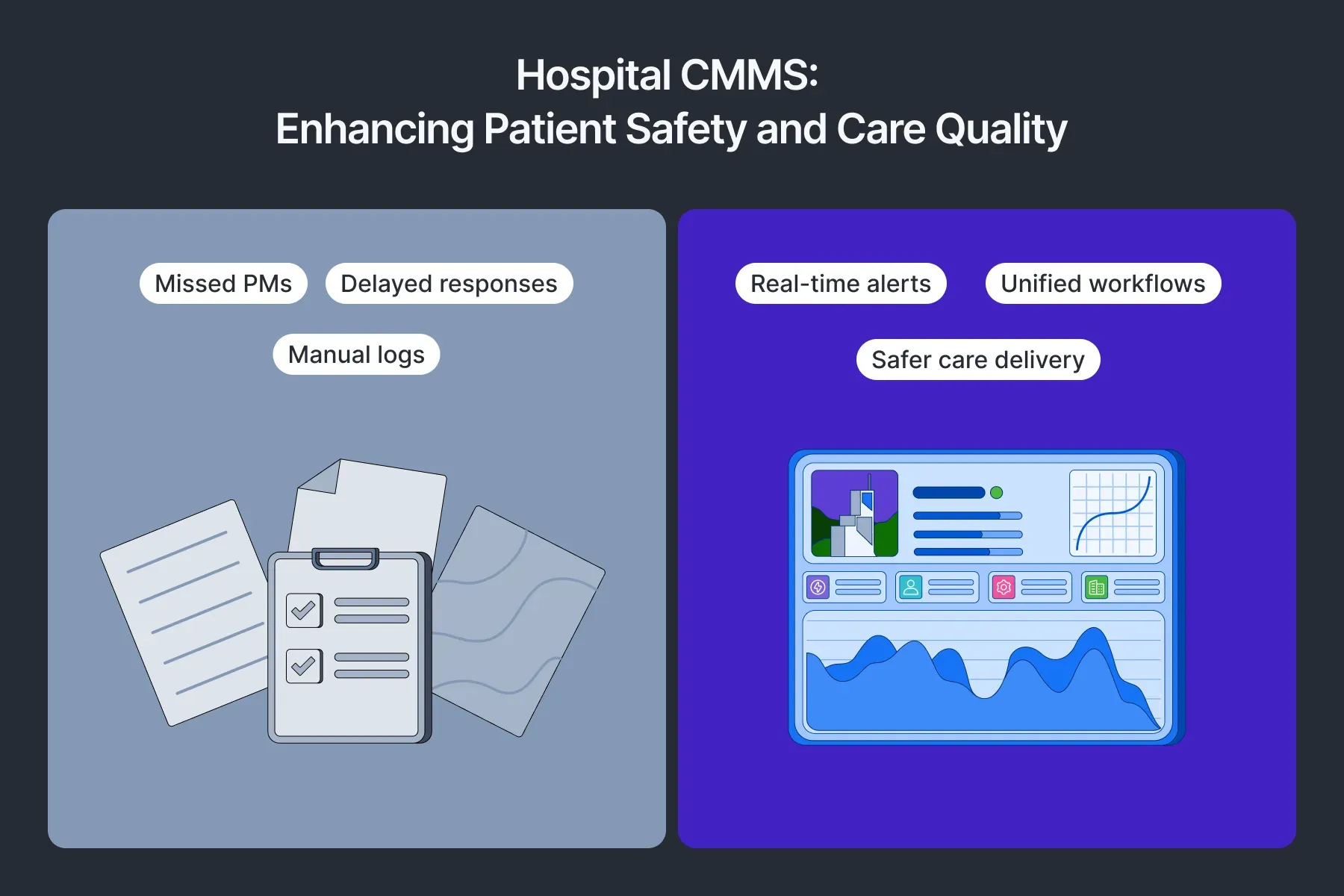
Hospitals today run on more than clinical expertise—they rely on complex infrastructure where even a few minutes of downtime can jeopardize patient care.
That’s why most hospitals in America use a Computerized Maintenance Management System (CMMS) to keep operations steady. But many are still using outdated systems that weren’t built for the pace or pressure of modern healthcare.
With equipment downtime costing hospitals as much as $740,000 per incident, and compliance tied directly to facility performance, legacy tools are no longer enough.
But that’s changing quickly.
Modern hospital CMMS platforms are transforming operations by integrating with IoT sensors, building systems, and predictive analytics. They help reduce unexpected failures, automate compliance documentation, and keep critical assets running smoothly.
As the market for hospital CMMS platforms continues to grow at 9.5% annually, it's clear this isn’t just a tech upgrade—it’s a strategic shift.
In this article, we’ll explore how advanced CMMS solutions are helping hospitals deliver safer care, ensure compliance, and protect what matters most: patient outcomes.
What is a Hospital CMMS?
The legacy hospital CMMS (Computerized Maintenance Management System) is specialized software built to manage the maintenance operations of healthcare facilities.
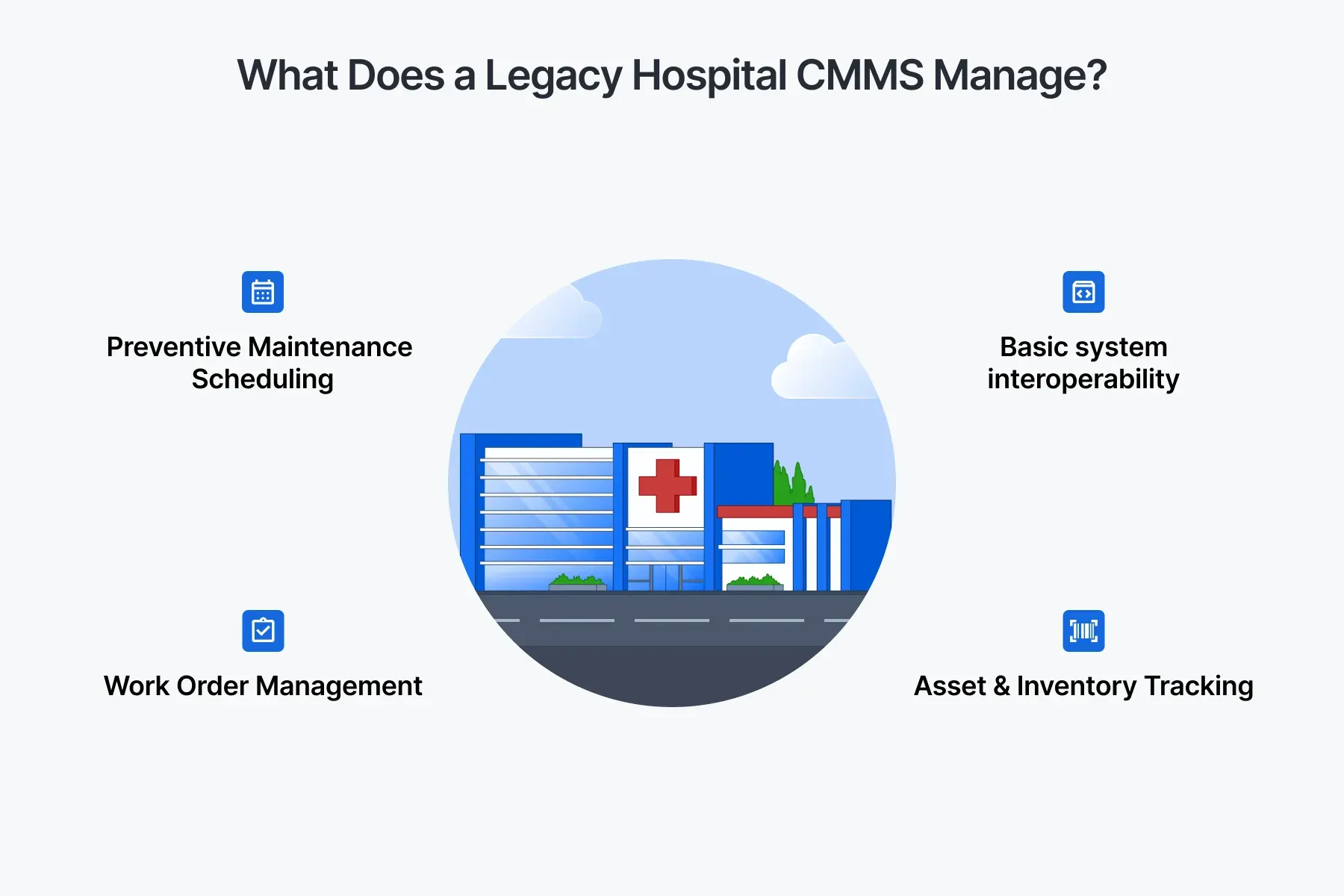
From life-saving medical equipment like MRI machines, CT scanners, ventilators, and infusion pumps to the infrastructure that supports them—such as HVAC, emergency power, and water filtration systems—a hospital CMMS helps ensure every system remains functional, safe, and compliant.
Designed for the complexity of healthcare environments, these platforms bring structure, traceability, and visibility to maintenance workflows, so that nothing falls through the cracks, even when operations are under clinical pressure.
Key functions of a legacy CMMS
- Preventive maintenance scheduling - Automates recurring maintenance tasks for clinical and facility assets, helping reduce unexpected failures and extend equipment life.
- Work order management - Tracks service requests from start to finish—ensuring technicians are dispatched efficiently and work is completed on time.
- Asset and inventory tracking - Provides real-time oversight of medical equipment and parts inventory, making it easy to locate, monitor, and manage critical resources.
- Basic system interoperability – Legacy CMMS platforms typically support limited integration with hospital infrastructure systems like Building Management Systems (BMS) or inventory tools. However, these integrations are often one-way or manually configured, offering foundational—but not fully connected—operational support.
By consolidating these functions into a single platform, a hospital CMMS enables healthcare facilities to minimize downtime, enhance response times, and maintain strict compliance—all while supporting improved patient care behind the scenes.
But here’s the catch: not all CMMS platforms are built for the pace, scale, and demands of today’s U.S. hospitals.
Many still rely on legacy systems that lack flexibility, integration, and real-time capabilities.
What does a modern, purpose-built hospital CMMS do differently?
A modern healthcare CMMS isn’t just software that logs work orders—it’s a connected operating system for hospital performance.
Purpose-built for healthcare, it unifies biomedical engineering, facilities management, and clinical support workflows into a single platform. But its true impact goes much deeper.
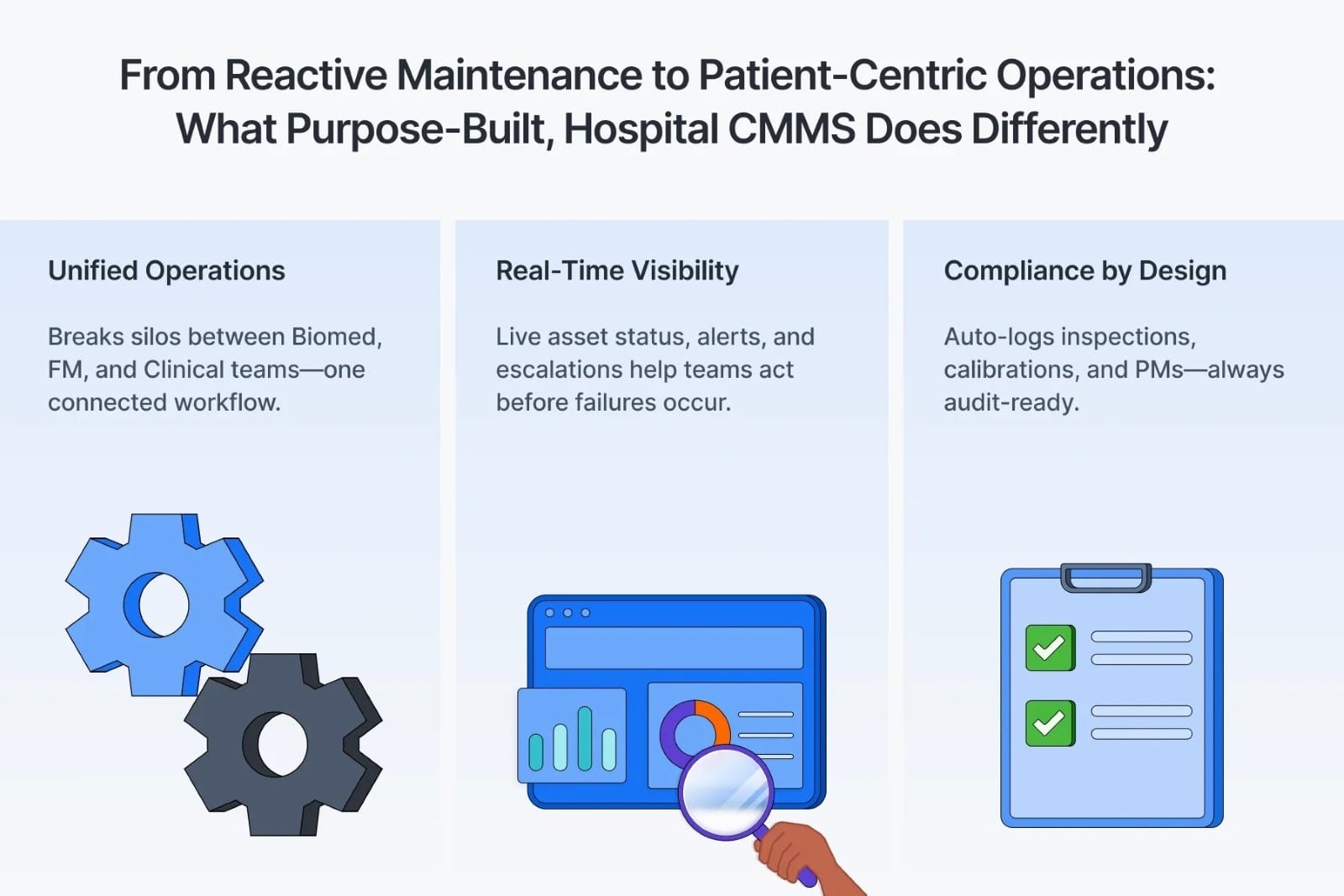
a) It standardizes operations across the entire health system
Most hospitals don’t have a CMMS problem—they have 27 different versions of one.
Every site tracks work differently.
Every technician uses their own spreadsheet.
Every audit looks a little different.
A modern CMMS helps hospitals standardize preventive maintenance schedules, compliance protocols, asset categorization, and escalation workflows across every facility. Whether you’re managing 3 hospitals or 300, the platform provides a single source of operational truth that everyone aligns to—from FM to Biomed to compliance.
Facilio Insight: With centralized templates, role-based SOPs, and shared asset libraries, Facilio gives health systems the consistency they need to scale safety and performance.
b) It turns real-time data into real-time decisions
Legacy systems bury data in exports and after-action reports. A modern CMMS surfaces live, operational intelligence—what’s overdue, what’s underperforming, what’s about to fail—and makes that data available at the point of action.
- Technicians see which work orders are highest priority
- Managers see risk flags on assets before they break
- Compliance leads see upcoming inspection gaps before surveyors do
Reporting isn’t a post-event PDF. It’s a dashboard your team acts on—every hour of every shift.
Facilio Insight: From AEM analysis to downtime tracking, Facilio brings clinical risk and compliance visibility into every maintenance and asset decision.
c) It works for every role, not just the admin who configured it
Legacy CMMS platforms are hard to navigate and even harder to adopt. They were built for admins, not frontline users. A modern CMMS is designed for FM techs, Biomed engineers, floor nurses, compliance officers, and contractors alike, with intuitive, mobile-first tools that support fast action and clean documentation.
Raise an issue. Scan an asset. Trigger a checklist. All in a few taps.
Facilio Insight: Facilio’s role-based interfaces, QR workflows, and mobile app ensure that everyone, from the boiler room to the OR, uses the system the same way, every time.
d) It’s configurable to fit the way you operate, not the other way around
Every hospital operates differently—different workflows, escalation rules, asset classes, and inspection intervals. A modern CMMS gives you the flexibility to configure forms, flows, hierarchies, and triggers based on how your hospital actually runs.
No need for workarounds, third-party bolt-ons, or weeks of vendor change requests.
Facilio Insight: With Facilio, you configure once and scale instantly, across departments, buildings, or the entire health system.
Ready to move beyond tickets and run real-time hospital ops?
Discover how Facilio's modern hospital CMMS Solution can work for you
Schedule a personalized demoWhy does your healthcare facility need a modern hospital CMMS?
A modern, purpose-built hospital CMMS isn’t just for tracking repairs—it’s an operational command center for clinical safety.
From managing biomedical devices and HVAC systems to coordinating disinfection workflows and enabling real-time technician response, it safeguards care environments at every layer.
1. Alternate Equipment Maintenance (AEM) Program enablement
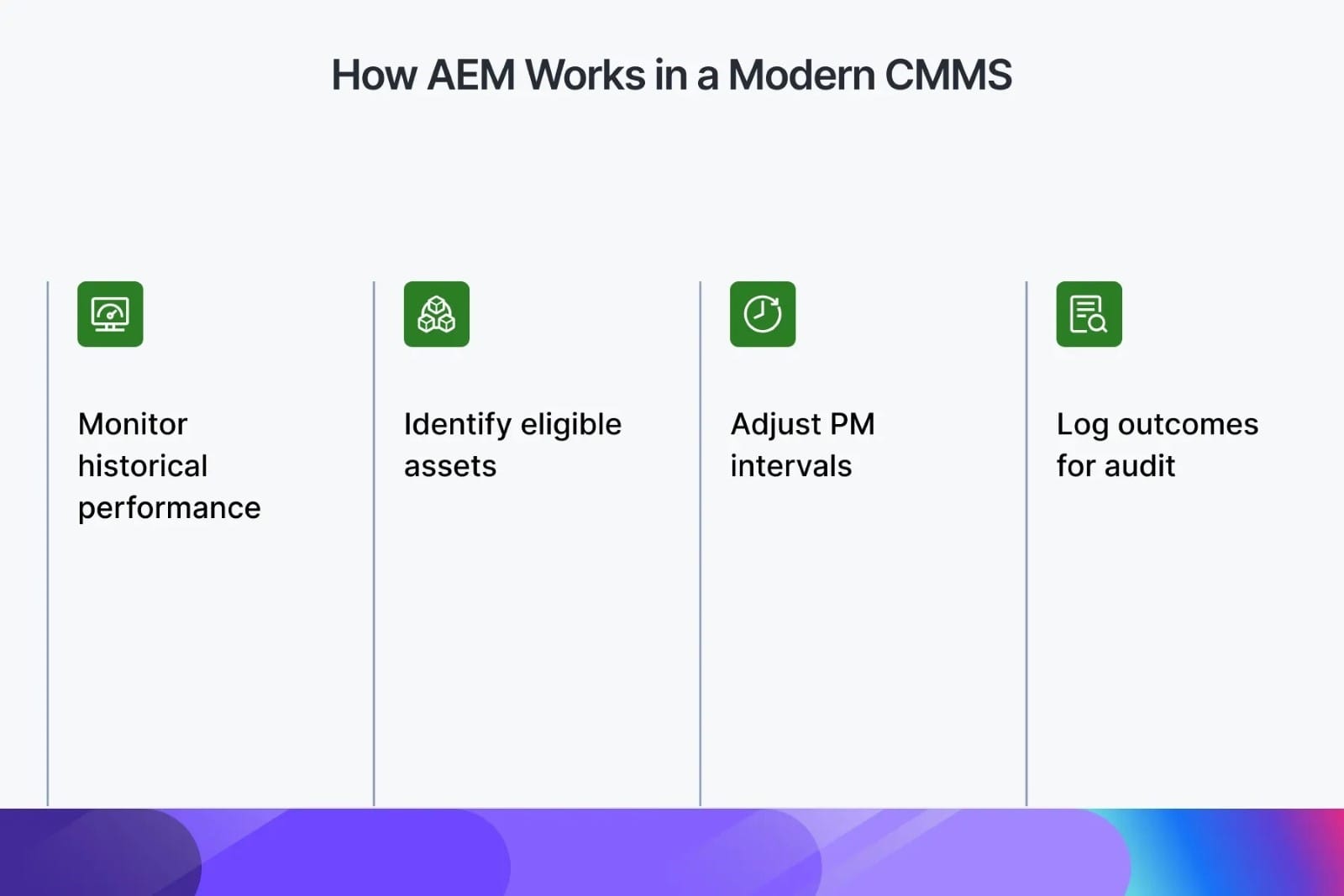
AEM programs are a recognized alternative to manufacturer-prescribed PM intervals—but only if hospitals can prove safety equivalence. A modern CMMS makes this possible by:
- Collecting and analyzing historical failure and service data
- Supporting AEM eligibility criteria as defined by CMS and TJC
- Automatically flagging assets that qualify for AEM
- Logging alternative schedules and outcomes for audit transparency
This allows hospitals to safely optimize PM frequency, lower maintenance overhead, and redirect resources to where they matter most, without compromising compliance.
Facilio Insight: With built-in support for AEM logic and documentation, Facilio helps hospitals stay compliant and efficient.
2. Cross-functional response across FM, HTM & clinical teams
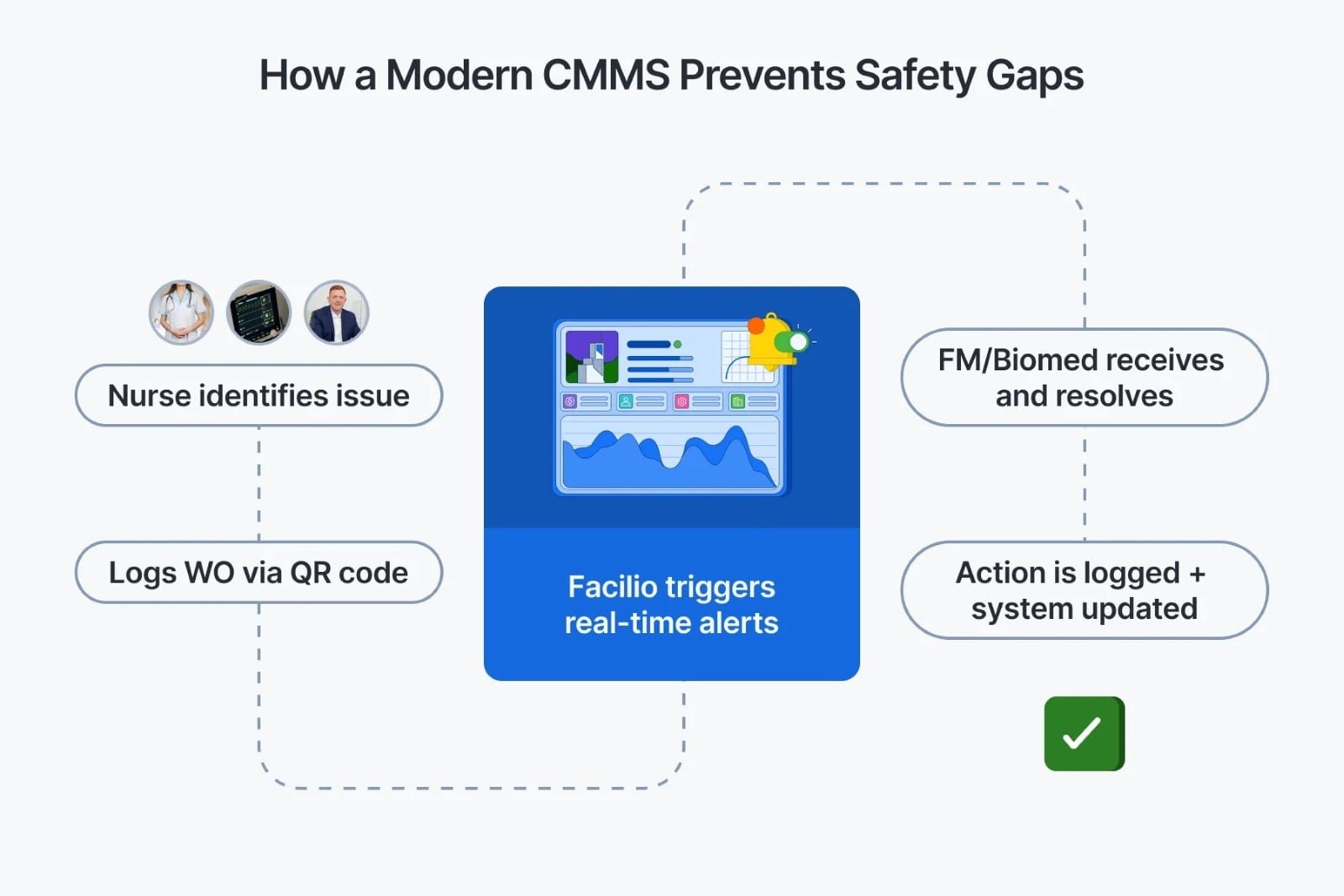
A modern hospital CMMS bridges the gap between clinical staff, Biomed, and Facilities.
It enables:
- Instant work order generation by nursing teams
- Live notifications for FM/HTM technicians
- Real-time visibility across teams on issue status and asset condition
This reduces miscommunication, speeds up issue resolution, and helps prevent small operational issues from becoming patient care disruptions.
Facilio Insight: Whether it's a downed IV pump or a faulty air handler, Facilio ensures the right team responds in minutes, not hours.
3. Built-in compliance automation
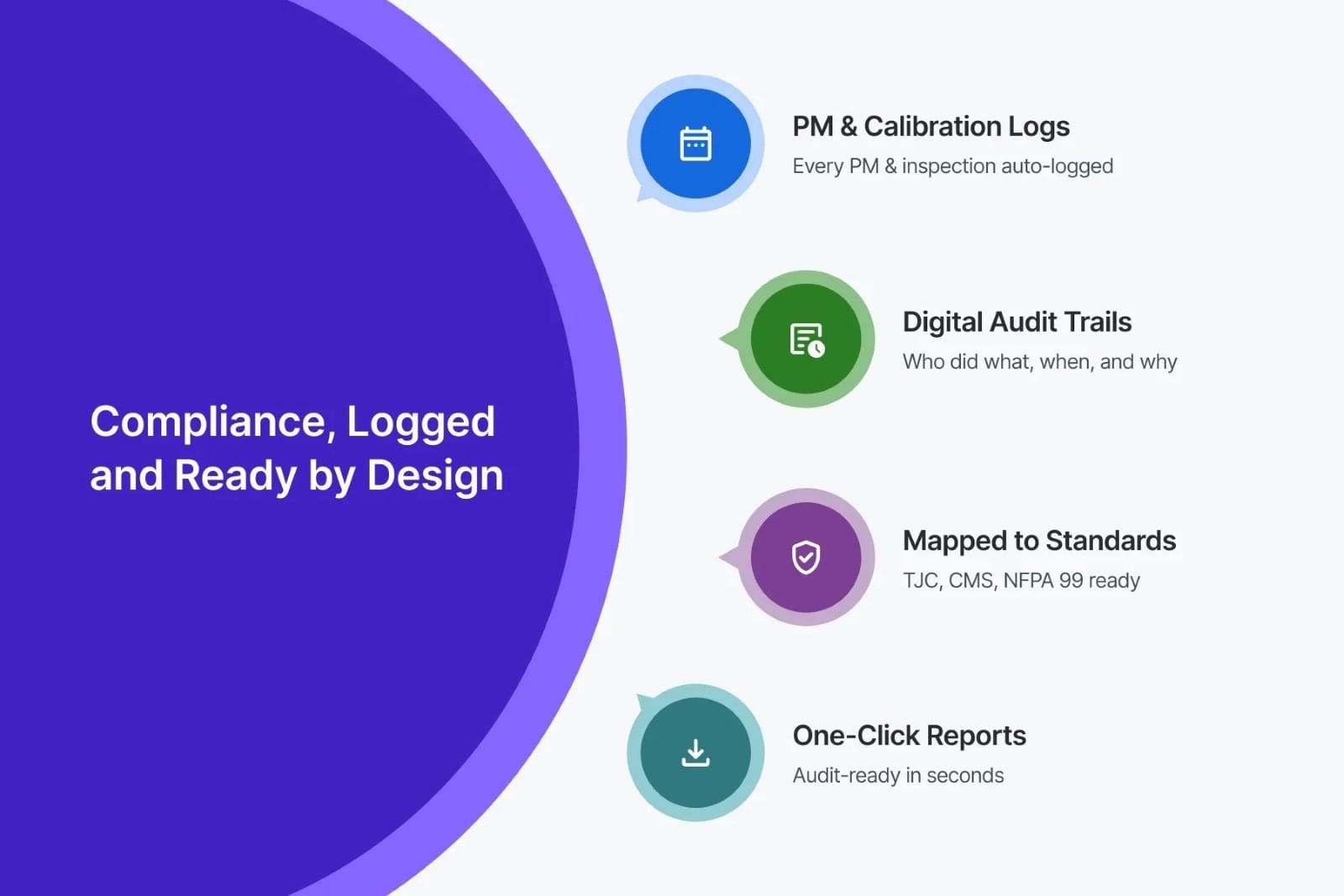
No more reactive scrambling during audits.
A hospital CMMS auto-captures:
- PM, CM, calibration, and safety inspections
- Audit trails for every asset and action
- Reports mapped to standards: TJC EC.02.05.01, CMS CoPs, NFPA 99
Your teams are always audit-ready, with clear documentation of who did what, when, and why.
Facilio Insight: With one-click export and fully digital audit trails, Facilio helps hospitals stay inspection-ready 24/7, eliminating the need for spreadsheets.
4. IoT-Driven monitoring of critical facilities and clinical assets
Connected hospital CMMS platforms integrate with IoT sensors and BMS to deliver real-time telemetry on:
- Oxygen and medical gas systems
- HVAC units in ORs and isolation rooms
- Dialysis water systems and life-safety infrastructure
When thresholds are breached—temperature, pressure, filtration flow—alerts are sent immediately, allowing teams to intervene before risk reaches the patient.
Facilio Insight: Facilio ingests live telemetry from connected infrastructure and clinical devices, giving your teams a real-time pulse on every critical system across the care environment.
5. Smart preventive maintenance based on risk and utilization
Instead of using static, calendar-based schedules, modern CMMS tools trigger preventive maintenance based on:
- Asset type and criticality
- Usage hours or cycles
- Environmental impact and location
- Failure trends
This ensures high-risk equipment like defibrillators or surgical sterilizers receive proactive servicing, while reducing over-maintenance of low-risk devices.
Facilio Insight: Facilio’s condition-based PM engine continuously recalibrates maintenance schedules using real-world usage data, preventing over-servicing and under-protection.
6. Operational visibility into day-to-day clinical enablers
From sanitation to safety, a connected CMMS ensures all “non-clinical” workflows are executed with clinical-level rigor:
- Monitors disinfection and room turnover
- Schedules and verifies safety infrastructure checks
- Documents service activities that impact the patient environment
This brings consistency, traceability, and accountability to hospital operations, directly reinforcing care quality.
7. Mobile + Cloud access for rapid action
Every second counts. A modern CMMS ensures:
- Techs and vendors get live updates and WO alerts via mobile
- Clinical staff can report issues by scanning a QR code
- Status, logs, and asset history are available in real-time
Whether you're fixing a failed bed in an ICU or replacing a suction unit in the surgery prep area, response happens in minutes, not hours.
Facilio Insight: Facilio transforms these “invisible” workflows into measurable care enablers, aligning environmental health with patient outcomes.
Regular legacy CMMS vs modern hospital CMMS—The difference in care outcomes
A hospital’s CMMS isn’t just a back-end tool—it directly affects how safely and efficiently care is delivered. Here’s how a modern, healthcare-grade CMMS like Facilio stacks up against the legacy systems most hospitals still rely on.
Legacy CMMS Software | Modern, Purpose-Built Hospital CMMS |
Calendar-based PMs PMs scheduled on static timelines regardless of asset usage or condition. Often leads to over-maintenance or critical failures between intervals. | Risk- and usage-based PMs with AEM support Schedules adapt based on real-world usage, past failures, and CMS-compliant AEM criteria—ensuring the right equipment gets attention at the right time. |
FM and Biomed work in silos Facilities and Clinical Engineering teams use separate systems, leading to delays, duplicate work, and lost accountability. | Unified workflows across all departments One connected platform aligns Facilities, Biomed, Nursing, and Compliance on shared assets, tickets, and response timelines. |
Manual compliance logs Technicians fill out paper logs or update Excel sheets; audits become fire drills and documentation is scattered. | Auto-logged, audit-ready inspection records Every PM, inspection, calibration, and corrective action is digitally timestamped and mapped to TJC, CMS, and NFPA standards. |
No mobile functionality Work orders can only be created or updated from desktops, delaying response time during critical events. | Mobile-first interface with live task alerts Technicians scan QR codes, update WOs, and close tasks from the floor—without ever logging into a desktop. |
Static, outdated dashboards Data is locked in reports and updated weekly/monthly—no ability to respond in real time. | Live dashboards and real-time asset status Instant visibility into asset health, technician activity, SLA performance, and compliance gaps—across all sites. |
Limited to maintenance operations Only handles maintenance tickets and asset logs—clinical workflows and operational readiness are out of scope. | Built for full clinical and facility operations Tracks sanitation cycles, room turnover, asset readiness, and environmental safety in addition to maintenance. |
Vendor coordination is manual Third-party vendors require emails or separate portals; no visibility into work progress or credentials. | Integrated vendor portals and access controls Vendors log tasks, upload documents, and complete service from within the CMMS—under one compliance roof. |
Not scalable for multi-site systems Each site has a different setup or instance; no shared benchmarks or standardized workflows. | Multi-site standardization & benchmarking Facilio scales across hospitals, clinics, and regions—standardizing PMs, WOs, inspections, and performance KPIs. |
Facilio: A CMMS purpose-built for safer, smarter hospitals
Most healthcare CMMS platforms hospitals use today were never built for healthcare’s pace, complexity, or consequences. They track work orders and maintenance logs, but they don’t talk to your building systems, can’t adapt to clinical urgency, and don’t help your teams make better decisions in real time.
Facilio changes that.
It’s not just a CMMS—it’s a unified operations platform designed specifically for hospitals. One that connects facilities, biomed, IT, and clinical teams in one ecosystem. One that turns asset data into action. One that puts patient safety, uptime, and compliance at the core of every maintenance workflow.
a) Real-time intelligence that anticipates risk—not just reports it
Facilio integrates with IoT devices, BMS, and hospital systems to surface live performance data across critical infrastructure—from negative pressure rooms to sterilization equipment.
- Detects deviations and failures before care is impacted
- Prioritizes work orders based on clinical urgency
- Reduces downtime across biomedical and facility assets
When every second counts, Facilio gives your teams the visibility to act fast—and the context to act right.
b) Compliance that’s continuous, not scrambled
Regulatory audits from TJC, CMS, NFPA 99, or FDA aren’t annual events—they’re a constant expectation. Facilio automates compliance by:
- Digitally logging every inspection, calibration, and PM task
- Generating audit-ready reports with zero prep time
- Supporting AEM programs with risk-based scheduling and documentation
No more binders, spreadsheets, or scrambling before inspections. With Facilio, compliance is just a byproduct of how you operate.
c) One platform for everyone involved in hospital ops
Legacy CMMS tools create silos—between facilities and HTM, vendors and staff, engineering and clinical teams. Facilio breaks those silos by giving everyone:
- A shared platform with role-based access
- Real-time status on work orders and asset health
- Mobile-first tools to raise, track, and resolve issues on the move
From nurse stations to boiler rooms, everyone works off the same source of truth.
Facilio: Proven at scale and trusted by large hospital networks
Facilio isn’t theory—it’s in action across complex healthcare systems managing hundreds of hospitals and clinics. It standardizes maintenance, centralizes compliance, and helps hospital leaders transition from reactive firefighting to proactive control.
Just ask Eurohealth Systems:
— Hanie Abdul Sathar, Director, Eurohealth Systems
Why settle for a legacy CMMS that’s just “Good Enough”?
Facilio is the only hospital CMMS platform that combines real-time data, system-wide visibility, and healthcare-grade compliance tools in one intuitive interface. Purpose-built to keep hospitals safer, smarter, and always one step ahead.
If your current CMMS is only helping you tick boxes, but not elevating the safety, efficiency, and responsiveness of your hospital operations, you’re not just behind; you’re exposed.

